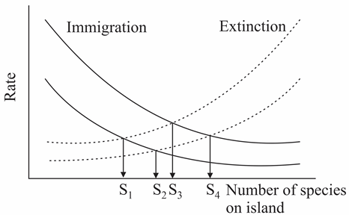HARD
NEET
IMPORTANT
Earn 100
Island biogeography theory states that the number of species on an island is determined by immigration rates of new species to the island and extinction rates of species on the island. Immigration rates to an island decline as its distance from the mainland increases and extinction rates decrease with increasing island size. When the immigration and extinction rates on an island are equal, the number of species on the island reaches equilibrium.

Which of the following gives the correct combination of distance (near and far) and area (small and large) of islands where species occur?

(a) near island, small island
(b) near island, large island
(c) small island, far island
(d) near island, large island
50% studentsanswered this correctly

Important Questions on Organisms and Populations
EASY
NEET
IMPORTANT
Autecology is the
EASY
NEET
IMPORTANT
Ecotone is
EASY
NEET
IMPORTANT
Biosphere is
EASY
NEET
IMPORTANT
Ecological niche is
EASY
NEET
IMPORTANT
According to Allen's Rule, the mammals from colder climates have
EASY
NEET
IMPORTANT
Salt concentration (salinity) of the sea measured in parts per thousand is
MEDIUM
NEET
IMPORTANT
Formation of tropical forests needs mean annual temperature and mean annual precipitation as
EASY
NEET
IMPORTANT
Which of the following forest plants controls the light conditions at the ground?
